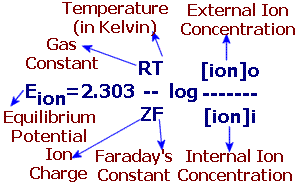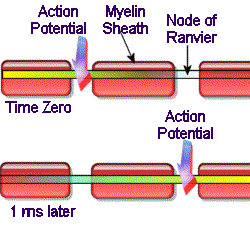
Neuroscience: A Journey Through the Brain
 |
Neuroscience: A Journey Through the Brain |
| Main Page Organization Development Neuron Systems About the site (Glossary) References |
The Action Potential
Jump to Section: Resting Potential | Action Potential | Conduction | Speed
1. The Resting Membrane Potential (back to top)
The resting potential of a typical neuron is around -65mV. Electrical charge is unevenly distributed between the inside and outside of a neuron, with the inside being more negative under normal resting conditions. The reason for this difference is the distribution of ions across the membrane. Calcium and Sodium ions are more concentrated on the outside, while Potassium ions are more concentrated on the inside, as well as impermeable anionic proteins. These concentration gradients arise because of ion pumps, mainly the sodium-potassium pump, which hydrolyzes ATP in the presence of internal sodium. The energy created exchanges an internal sodium for a potassium ion.
|
Other
important terms are: At rest, the membrane is highly permeable to potassium, and allows a small leakage of sodium. Each ion has it's own Equilibrium Potential, the steady electrical potential that would be produced if the membrane were permeable to only that ion. We can use the Nernst Equation (shown to the right) to calculate this value. |

|
However, the membrane is permeable at rest to several ions, and their relative permeability must be taken into consideration when calculating the membrane potential. If we consider only sodium and potassium, the membrane is 40 times more permeable to potassium than to sodium, which predicts a resting membrane potential of about -65 mV (which is exactly what we observe!). The equation used to calculate the membrane potential is the Goldman Equation.
2. The Action Potential (back to top)
|
Threshold: Threshold is the membrane potential at which enough
voltage-gated sodium channels are open so that the relative permeability
of the membrane is higher for sodium ions than it is for potassium ions. |
|
Refractory periods: The absolute refractory period is due to the inactivation of sodium channels. These channels cannot be opened again until the membrane potential is sufficiently negative to deinactivate them. The relative refractory period is due to the hyperpolarization from the open potassium channels. This means that more depolarizing current is necessary to initiate another action potential.
3. Action Potential Conduction (back to top)
In order for information to be transferred in the nervous system, the action potential, once generated, must travel down the axon. The propagation of the action potential occurs because the influx of positive charge during the rising phase depolarizes the next segment of the membrane. In this way, the action potential works its way down the axon to the terminal, and initiates synaptic communication with another neuron or cell. An action potential travels only in one direction; it cannot turn back on itself because the membrane behind it is still refractory due to the inactivation of sodium channels. Action potentials propagate without decrement, and are called an "All or none" signal.
4. The Factors Influencing Action Potential Conduction Speed (back to top)
|
Axon diameter and pores: The sodium influx
results in the depolarization of the next segment of membrane, and the
speed of action potential propagation depends in part on how far ahead
this depolarization spreads. There are two paths the positive charge can
take: one, down the inside of the axon; the other, across axonal
membranes. Thus, if the axon is wide and there are few open membrane
pores, most of the current will flow inside the axon, and result in faster
conduction speed. |
 |
Created and Maintained by: Melissa
Davies
Last Updated: April 09, 2002 08:58 PM